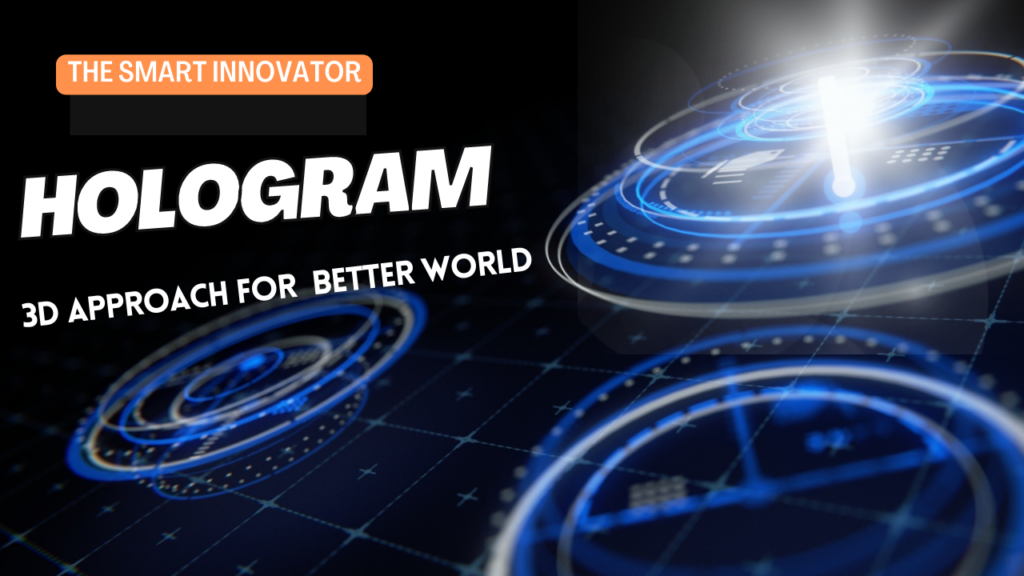Hologram : 3D Approach for a better world
In recent years, holograms have captured our imaginations, bringing the future to life with their captivating and realistic 3D visualizations. What was once confined to science fiction is now becoming a reality, with holographic technology transforming various industries and revolutionizing the way we interact with digital content. Remember the Iron man’s Representation of new element discovery? That’s was the hologram Representation of the information we have in general and we analyses it in graphic manner. So in this very interesting topic Hologram : 3D Approach for a better world we brought some innovative discussion to your plate.

From entertainment and healthcare to education and communication, holograms are paving the way for a better world. In this article, we will explore the world of holograms, their applications, and the impact they have on shaping our future.
Hologram basically are the projections 3D graphics points which take real time shapes of the particular things which help us to understand things better.It’s another form of we discuss it in augmented reality which takes real life place to build its 3D hologram.
Hologram made by light field rather than an image from lenses. Holograms can also be used to store, retrieve, and process information optically.
The Power of Holograms
Holograms, unlike traditional 2D images, create immersive 3D visuals that appear to float in space, giving viewers a sense of depth and realism. This technology is made possible through the use of lasers, diffraction, and interference patterns. Holograms can be projected onto surfaces or displayed through specialized devices, enabling a range of applications across various industries.
Applications of Holograms
- Entertainment: Holograms are revolutionizing the entertainment industry, allowing for awe-inspiring live performances and virtual experiences. From holographic concerts featuring deceased artists to interactive holographic displays at theme parks, holograms are pushing the boundaries of entertainment.
- Healthcare: In the field of healthcare, holograms are transforming medical training, surgical planning, and patient care. Surgeons can use holographic imaging to visualize patient anatomy in 3D, aiding in precise surgical procedures. Holograms also play a crucial role in medical education, allowing students to explore detailed anatomical structures.
- Education: Holograms have immense potential in education, providing immersive learning experiences that enhance student engagement. From virtual field trips to historical landmarks to interactive 3D models of scientific concepts, holograms make complex subjects more accessible and captivating.
- Communication: Holograms are revolutionizing communication by enabling realistic virtual meetings and presentations. With holographic teleconferencing, participants can interact as if they are in the same room, fostering collaboration and eliminating geographical barriers.
Hologram Vs Photography
- A photograph can be recorded using normal light sources (sunlight or electric lighting) whereas a laser is required to record a hologram.
- A lens is required in photography to record the image, whereas in holography, the light from the object is scattered directly onto the recording medium.
Objects are more clear and understandable in Hologram form, in this we don’t need an object itself, its projection works nice for us. Even in election leaders are using 3D approach for rallies in multiple places at the same time like Trump in US and Modi in India had performed.
How to Make a Hologram
Holograms have a captivating allure, transporting us to a world where objects come to life in three-dimensional glory. Creating your own hologram might sound like a daunting task, reserved for technical wizards or mad scientists. However, with the right knowledge and a few simple materials, you too can unlock the magic of holography. In this article, we will guide you through the process of making a hologram, step by step.
Materials Needed
To make a basic hologram, you will need the following materials:
- Holographic film or plate
- Laser (preferably green or red)
- Object or subject to holograph (small and simple objects work best)
- Darkroom or a controlled environment with minimal ambient light
- Holographic developer (chemicals used to process the hologram)
Step-by-Step Guide
- Prepare the Object: Choose a small object that you want to holograph. Clean it thoroughly to remove any dust or fingerprints that may affect the clarity of the hologram.
- Set up the Darkroom: Find a darkroom or create a controlled environment with minimal ambient light. It is essential to eliminate any light interference during the holography process.
- Position the Laser: Place the laser in a stable position so that it shines directly onto the holographic film or plate. Ensure the laser beam is aligned properly and has a clear path to the film.
- Capture the Hologram: Position the object in front of the holographic film or plate. Make sure the laser beam illuminates the object, creating a reflection on the film. You may need to experiment with different angles and positions to achieve the desired holographic effect.
- Expose the Film: Turn on the laser and expose the holographic film to the object’s reflection for a specific duration. The duration depends on the type of film and the desired hologram quality. Follow the instructions provided with the holographic film for accurate exposure times.
- Develop the Hologram: After the exposure, carefully remove the holographic film and process it using the holographic developer. The developer chemically develops the hologram, revealing the hidden three-dimensional image. Follow the developer’s instructions for the appropriate development time.
- Rinse and Dry: Rinse the hologram with water to remove any residual chemicals from the development process. Gently pat it dry with a lint-free cloth or allow it to air dry in a clean environment.
How does Hologram work
Holograms work through the principles of interference and diffraction of light waves. Unlike traditional photographs or images that are captured on a flat surface, holograms capture and display three-dimensional information, giving the illusion of depth and spatial presence. Here’s a simplified explanation of how holograms work:
- Recording the Hologram: To create a hologram, a laser beam is split into two parts: the object beam and the reference beam. The object beam is directed towards the object or scene that you want to capture as a hologram. The reference beam is directed onto a recording medium, typically a holographic film or plate.
- Interference and Recording: As the object beam interacts with the object, it reflects off its surface, capturing the object’s shape and details. The object beam and reference beam then intersect at the recording medium. This intersection creates an interference pattern, where the two beams interact and create areas of constructive and destructive interference.
- Interference Pattern Encoding: The interference pattern contains information about the phase and amplitude of the combined object and reference beams. This pattern is recorded on the holographic film or plate, which can capture and store the complex interference pattern.
- Reconstruction: To view the hologram, a coherent light source, usually a laser, is used to illuminate the recorded hologram. When the laser light passes through the holographic film, it diffracts and recreates the original object wavefront. This diffraction process reconstructs the 3D image contained within the hologram.
- Perception of Depth and Realism: As the reconstructed light waves reach our eyes, they produce an optical illusion of depth and spatial presence. Our brain processes the information received from the hologram, creating the perception of a three-dimensional object or scene.
Facts about Hologram
It’s important to note that holograms are highly dependent on the quality of recording and reconstruction processes. Factors such as the wavelength and coherence of the laser, the quality of the recording medium, and the precision of the optical setup impact the clarity and realism of the holographic image.
Holography is a complex field that continues to advance with advancements in technology. Today, holograms are not only limited to holographic films or plates but also include holographic displays, where special techniques project light in specific ways to create a similar 3D effect. This allows for more interactive and dynamic holographic experiences in various applications, including entertainment, healthcare, education, and more.
Conclusion
Holograms have emerged as a powerful tool with the potential to reshape our world. From transforming entertainment and healthcare to revolutionizing education and communication, holograms offer a new dimension of immersive and engaging experiences. As technology continues to advance, we can expect holograms to play an even more significant role in our lives, creating a better world where reality and virtuality seamlessly blend.
Embrace the holographic revolution and embark on a journey where the boundaries between the physical and virtual worlds blur, opening up a realm of endless possibilities for creativity, communication, and innovation. The future is holographic, and it promises a truly transformative
This tech is exciting and has a very bright future as we can see in science fiction movies too but in reality more realistic approach is still in progress. So in this post Smart Innovator brings some ground particles of hologram into the light. We will share more in this in holographic way. Stay tuned.






0 Comments